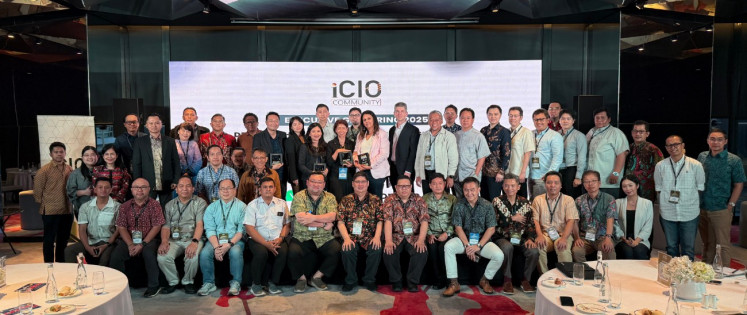Popular Reads
Top Results
Can't find what you're looking for?
View all search resultsPopular Reads
Top Results
Can't find what you're looking for?
View all search resultsThe end-to-end networking demands of an Internet of Things
The end-to-end networking demands of an Internet of ThingsThe Internet of Things (IoT) will facilitate the need for engineers to look at end-to-end network solutions far beyond that of the data center
Change text size
Gift Premium Articles
to Anyone
The end-to-end networking demands of an Internet of Things
The Internet of Things (IoT) will facilitate the need for engineers to look at end-to-end network solutions far beyond that of the data center.
It will place greater demands on nodes and the network infrastructure than ever before, creating significant engineering challenges. Building such a network will require efficient use of silicon at every stage that meets both performance and budgetary requirements.
To understand the network challenges that an IoT brings, one has to appreciate not just the scale, but the diverse locations in which data will be collected and then sent to the data center.
It is now accepted that an IoT will be one of the key drivers for the big data phenomenon, but what is often ignored is the means by which data will be transported from the sensors to the data center. This includes challenges such as the last mile, insufficient networking technologies, a significant increase in base station processing and storage requirements, and bringing new technologies for interconnect and workload efficient processing at the data center.
Networking has, for decades, faced challenges providing a high QoS at the last mile.
Traditionally, the Internet's last mile has been homes and small offices: stable locations that primary require downstream bandwidth. But over the past five years this has expanded to smartphones and tablets, increasing the need for upstream bandwidth.
Wireless networking standards such as WiMax and Long Term Evolution (LTE), also known as 4G networks, have sought to increase bandwidth and decrease latency to the end user. While deployment of LTE networks may be patchy, they serve as an indicator of how network requirements are changing in order to provide higher levels of QoS.
To improve performance, LTE base stations require more processing power and system memory, making 64-bit processors such as AMD's G-Series SOC a requirement for packet routing and caching content at the network edge. The goal is to lower latency and utilization on the backhaul link, while delivering users 'hot' content faster.
Due to the significant financial investment needed to deploy high bandwidth wireless networks, these networks are usually deployed in areas where operators see potential for high revenue and not those in remote locations where sensors, such as those that monitor the status of pumps for crop irrigation, will need to be.
Aside for wireless standards, the source of data that is often in remote locations poses major network deployment and maintenance challenges. Moreover, the basic QoS that an IoT will demand is higher than many would have imagined - even just a few years ago.
The need for integrity, whether it be the correct reporting of data or the secure transmission of data from source to data center will be vital to the creation of a true IoT.
Securing and obfuscating personal data is another challenge for IoT. Some of this can be handled by the user's device.
However, there is some data that will need to retain personal information. For example, a temperature sensor that recognizes a user and sets the thermostat according to their preference. In this case, the sensor will need to encrypt the data prior to sending it on the network in order to preserve the user's privacy. This will require the processors to have silicon dedicated to encryption to increase performance and decrease power utilization, such as the dedicated security block on the AMD Geode LX processor.
Massively deployed, low-cost sensors may not have the computation capability present on-device to meet real-time data encryption requirements. If that's the case, an alternative scenario would be to have sensors send data to a server that is on its local network, meaning that the sensors themselves are not connected to a wide area network but uses a base station as a network gateway.
The base station has to handle all encryption duties in real time to preserve QoS posing significant computation requirements. Not only is the computation requirement significant, but when allied to the fact that these processors will have to be rugged and meet low power utilization, one can start to appreciate the challenge of designing an efficient data transport mechanism from the field to the data center is not trivial one, and especially since the challenges don't stop once the data has entered the data center.
Once in the data center, that data has to be processed across devices via an interconnect into meaningful information. Not all interconnects within the data center are equal, as different protocols excel at certain workloads.
Many companies are moving to fabric compute models, like AMD's Freedom Fabric, which facilitates the transfer of information between nodes within the data center ' from compute to storage and vice versa, while meeting performance and energy requirements.
An efficient compute fabric will manage the transport of granular data within the data center, using lightweight protocols that provide optimal bandwidth and latency. Traditional network topologies have revolved around a central switch. However, point-to-point fabrics allow for nodes to directly communicate with each other, bypassing the need for an external switch and decreasing latency.
A true IoT will push the boundaries of computation and networking technology to allow data capture in hostile locations and provide a high performance, resilient and secure data path for millions of sensors.










